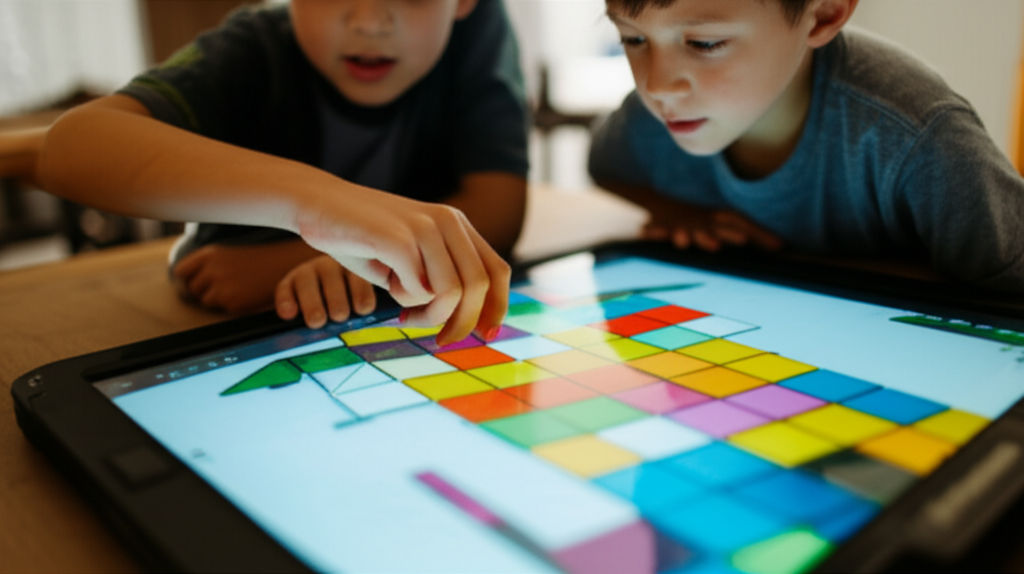Benefits of Technology for Kids Under 12
Ikhsan Rizki

Photo: Unlock the benefits of mindful tech for kids under 12! Boost learning, cognitive skills, and creativity to foster future-ready, well-rounded children.
Technology has become an undeniable part of our lives, and for children under 12, it's more than just entertainment; it's a tool that can profoundly shape their development. While concerns about screen time are valid, understanding the Benefits of Technology for Kids Under 12 reveals a landscape rich with opportunities for growth, learning, and connection. This article will explore how technology, when used mindfully, can be a powerful ally in nurturing well-rounded, future-ready children.
Unlocking Educational Potential
Forget the image of passive screen time; modern technology offers a dynamic learning environment. Educational apps and interactive platforms are transforming how children acquire knowledge.
Interactive Learning Experiences
Technology can make learning engaging and fun. Educational apps and games often include puzzles and challenges that enhance problem-solving and critical thinking skills. Children can actively participate and experiment with different ideas, rather than just passively receiving information. For instance, apps like ABCmouse.com and Khan Academy Kids offer comprehensive curricula covering subjects from reading and math to science and art, often with interactive activities and engaging characters. These tools can make learning feel like a playful adventure, fostering curiosity and motivation.
Enhancing Core Academic Skills
Beyond general engagement, technology directly supports the development of foundational skills.
- Literacy and Language Development: Interactive language learning apps and digital storybooks can help children build vocabulary, improve reading comprehension, and even learn new languages. Apps like Endless Alphabet introduce new words through puzzles and animations, making learning enjoyable.
- Math and Logic: Educational games designed to improve math skills provide interactive and timed challenges that help children practice arithmetic and advance their mathematical abilities. Coding apps and games, such as Scratch or Tynker, teach logic and problem-solving, crucial for STEM foundations.
- Memory and Attention: Certain interactive games and educational apps have been shown to enhance children's attention spans and memory recall by engaging them in focused, task-oriented activities.
Fostering Cognitive Development
Technology's impact extends to broader cognitive functions, helping young minds develop essential skills for navigating a complex world.
Problem-Solving and Critical Thinking
Many educational games and apps are designed to challenge children to solve puzzles, plan strategies, and make decisions, thereby enhancing their cognitive flexibility and executive functioning. Children can experiment with different solutions and brainstorm ideas, developing innovative problem-solving approaches.
Boosting Creativity and Expression
Technology provides a powerful canvas for creative expression, allowing children to explore their artistic and imaginative sides in new ways.
- Digital Art and Music: From digital drawing applications to music production software, children can create digital art, compose music, and even code their own video games. Platforms like Storybird allow children to write, illustrate, and share their own stories.
- Interactive Storytelling: Apps and platforms enable children to craft interactive narratives using digital elements like images, text, and audio, fostering their storytelling skills and imaginative thinking.
- Video Creation: Children can learn video editing and GIF creation, developing technical skills and attention to detail as they produce their own media.
Cultivating Social and Emotional Growth
While often seen as isolating, technology can also be a bridge to social and emotional development, especially when used collaboratively and with guidance.
Improved Communication Skills
Digital tools can help children communicate effectively. Video calls allow them to stay in touch with distant family and friends, while collaborative online platforms enable them to work together on projects, sharing ideas and providing feedback. This fosters empathy, cooperation, and compromise.
Enhancing Social-Emotional Learning (SEL)
Technology can provide tools that support emotional development and self-awareness.
- Empathy and Understanding: Interactive storytelling and games can present scenarios that teach compassion and understanding for others, helping children learn how emotions relate to situations and appropriate responses.
- Collaboration and Teamwork: Many educational platforms and games are designed for group settings, promoting social interaction and cooperative problem-solving. Through activities like virtual hackathons or group art projects, children learn to communicate effectively and manage team dynamics.
- Self-Awareness and Self-Expression: Digital tools like surveys, quizzes, and journals can help children assess their social-emotional skills and reflect on their experiences, promoting self-awareness and self-improvement.
Preparing for a Digital Future: Digital Literacy
In an increasingly digital world, early exposure to technology helps children develop essential digital literacy skills, preparing them for future academic and career paths.
Navigating the Digital World Safely
Digital literacy is about more than just knowing how to use devices; it's about understanding technology's role, evaluating content critically, staying safe online, and communicating responsibly. Children learn to recognize misinformation, protect their privacy, and understand online risks like cyberbullying.
Essential 21st-Century Skills
Exposure to technology from a young age equips children with skills crucial for the future workforce, such as problem-solving, creativity, adaptability, and the ability to use digital tools effectively. This early foundation gives them a head start in a technology-driven society.
Mindful Integration: Ensuring Positive Outcomes
The key to harnessing the Benefits of Technology for Kids Under 12 lies in mindful and balanced integration. Technology should complement, not replace, traditional learning experiences and real-world interactions.
- Balance Screen Time: While the average screen time for children aged 8-10 can be around six hours daily, the American Academy of Pediatrics recommends limiting recreational screen time for children aged 2-12 to about one hour per day. This allows for ample time for physical play, reading, and face-to-face interactions.
- Quality Over Quantity: Focus on interactive, educational content rather than passive viewing. Co-viewing with a parent or caregiver is recommended, especially for younger children, to facilitate discussion and understanding.
- Parental Involvement: Parents should familiarize themselves with the content their children consume, use parental controls, and discuss online experiences openly. Modeling healthy screen habits is also crucial.
Conclusion
The narrative around technology and children is evolving. When approached thoughtfully and with clear boundaries, the Benefits of Technology for Kids Under 12 are undeniable. From enhancing academic skills and fostering cognitive development to nurturing creativity and building crucial social-emotional competencies, technology can be a powerful tool for preparing children for a bright, digital future. It's not about avoiding technology, but about embracing its potential responsibly.
What positive impacts of technology have you observed in the children in your life? Share your experiences in the comments below!
Frequently Asked Questions (FAQ)
Q1: How much screen time is recommended for kids under 12?
The American Academy of Pediatrics (AAP) recommends no screen time for children under 18 months (except for video chatting with family), limited, high-quality programming co-viewed with an adult for ages 18-24 months, and no more than one hour per day for children aged 2-5 years. For children aged 5 and older, consistent limits on daily screen time and types of media should be set, generally aiming for no more than two hours of recreational screen time per day.
Q2: Can technology really help with a child's cognitive development?
Yes, when used appropriately, technology can support cognitive development. Educational games and apps can enhance problem-solving, critical thinking, memory retention, and language acquisition skills. Interactive content that requires children to follow instructions, make decisions, and solve puzzles can significantly contribute to their cognitive flexibility.
Q3: What kind of technology is most beneficial for young children?
The most beneficial technology is interactive and educational, promoting active engagement rather than passive consumption. This includes educational apps, coding platforms, digital art and music creation tools, and interactive storytelling platforms. Tools that encourage creativity, problem-solving, and collaboration tend to offer the most significant benefits.
Q4: How can parents ensure safe and responsible technology use for their children?
Parents can ensure safe and responsible use by setting clear screen time limits, co-viewing content with their children, and using parental controls. It's also crucial to teach children about online privacy and safety, encourage critical thinking about online content, and model healthy digital habits themselves. Open discussions about online experiences are also highly recommended.
Business
View All
August 30, 2025
Cast of Mind Your Business Show TodayDiscover the stars of Bounce TV's "Mind Your Business"! Get to know the cast behind the laughs in this hit family comedy series.
Ikhsan Rizki

November 14, 2025
When to Hire a Business Litigation LawyerFacing business disputes? Discover when to hire a business litigation lawyer to safeguard your company's stability, reputation, and finances.
Ikhsan Rizki

October 13, 2025
Real Estate Business Cards That WorkReal estate business cards still work! Learn to create powerful cards that stand out, make connections & boost your real estate business.
Ikhsan Rizki

September 17, 2025
BA A380 Business Class Flight ReviewConsidering BA A380 Business Class? This review covers everything from lounges to seat comfort, helping you decide if Club World delivers a premium flight.
Ikhsan Rizki

September 14, 2025
What Is a Firm in Business TermsConfused by "firm" in business? This article clarifies what a firm is, its types, and how it differs from a company. Master this key term!
Ikhsan Rizki

October 2, 2025
Utah SOS Business Search HelpUnlock crucial business info in Utah! Learn how to use the Utah SOS Business Search for name availability, due diligence, status checks & more.
Ikhsan Rizki
Economy
View AllIs Singapore Airlines Premium Economy worth the upgrade? Dive into the real experience, from priority perks to seat comfort, and decide for your next journey.
Ikhsan Rizki
Is the Chevy Colorado fuel-efficient? Get 2023-2025 MPG ratings, real-world factors, and tips to maximize gas mileage. Make a smart truck choice.
Ikhsan Rizki
Save big on Las Vegas Airport parking! This guide covers LAS economy parking, locations, rates & shuttles for a stress-free, budget-friendly trip.
Ikhsan Rizki
Discover the profound economic impact of the Baby Boomers. Learn how this massive generation shaped consumer trends, labor, and today's economy.
Ikhsan Rizki
Dreaming of Daytona Beach on a budget? The Atlantic Economy Inn offers affordable stays steps from the beach with a pool & free WiFi. Your savvy guide!
Ikhsan Rizki
What is the Low Altitude Economy? Explore this new frontier where drones & air taxis revolutionize delivery, travel, and more above us.
Ikhsan Rizki
Education
View AllSeeking top PreK-8 education? Forest Lake Education Center (FLEC) offers academic excellence, Christian values & holistic growth.
Read MoreNavigate Nicholas County Board of Education updates easily! This guide empowers parents, students & the community to stay informed, advocate, and engage for sch...
Read MoreUnlock your potential in pharmacy! Discover Pharmacy Times CE, your accredited guide to staying current, meeting licensure, and enhancing your practice.
Read MoreUnlock your healthcare career with Mercy Hospital's diverse education programs. From foundational training to advanced residencies, find your path to success.
Read MoreConsidering a pharmacy career? Learn the exact educational journey, from prerequisite courses to the Pharm.D. degree, to become a vital healthcare expert.
Read MoreUnlock the potential of specialized learning at North Education Center. This guide explores tailored programs and a nurturing environment for unique student nee...
Read MoreHealth
View All
November 26, 2025
What Harris Health Smith Clinic OffersSeeking comprehensive healthcare in Houston? Harris Health Smith Clinic provides accessible primary care, specialty access, and patient-centered wellness.
Ikhsan Rizki

September 1, 2025
Start Your Career at Denver HealthYour guide to a fulfilling healthcare career at Denver Health. Discover diverse opportunities, benefits, and how to apply to a leading system.
Ikhsan Rizki

August 22, 2025
Careers at Cone Health Right NowExplore careers at Cone Health! Discover a supportive culture, great benefits, and make a real impact in healthcare. Join a Great Place to Work®.
Ikhsan Rizki

November 5, 2025
Orlando Health Patient Portal InfoTake control of your health! Discover the Orlando Health Patient Portal (MyChart) for easy access to records, appointments & secure messaging.
Ikhsan Rizki

August 9, 2025
In Good Health Sandwich Menu PicksTransform your sandwich into a healthy meal! Learn smart choices for bread, lean protein, and veggies to fuel your body without guilt.
Ikhsan Rizki

November 7, 2025
Primary Health Medical Group Near YouSimplify finding your ideal Primary Health Medical Group. Our guide helps you choose a trusted healthcare partner for comprehensive, long-term well-being.
Ikhsan Rizki
Popular Articles
View All
1
2
3
4
5
6
7
8
9
10
Lifestyle
View All
November 12, 2025
What is lifestyle RP and who plays it
Live a second life! Explore Lifestyle RP, an immersive digital world of realistic characters, social interaction, and unique storytelling. Get started here.

October 28, 2025
What a Lifestyle Lift Really Costs
Considering a mini facelift? Learn the *true* cost beyond the sticker price. Understand all factors for an informed decision on your rejuvenated look.

September 9, 2025
Skyn Condom Size Guide From Lifestyles
Unlock comfort & safety! Our Skyn condom size guide helps you find your perfect fit for enhanced pleasure and peace of mind. Non-latex options too.

August 5, 2025
Beauty and skincare lifestyle tips that work
Unlock radiant skin! Discover proven beauty & skincare lifestyle tips that work from the inside out. Cut through the noise for a natural glow.

November 20, 2025
Best Medical Fields for Lifestyle
Achieve work-life balance in medicine! This guide reveals top medical fields with predictable hours, fewer emergencies, and lower stress for a fulfilling career...

September 20, 2025
Why Barefoot Lifestyle Is Gaining Fans
Reconnect with your natural foundation. Explore the science behind why barefoot living improves foot strength, balance, and overall health.

August 18, 2025
Inside Soul Lifestyle Apartments
Soul Lifestyle Apartments: Redefine urban living with top amenities, vibrant community, and unmatched convenience. Find your ideal modern home.

August 9, 2025
DnD Lifestyle Ideas to Try
Level up your reality! Discover practical, fun ways to infuse your everyday life with D&D magic, from home decor to fashion. Embrace the adventure!
Sports





Travel
View All
November 19, 2025
Where to Travel in August Top Destinations
Where to Travel in August: Your Ultimate Guide to Top Destinations August often presents a unique travel dilemma. On one hand, it's peak summer for many, brimmi...

November 13, 2025
RDR2 fast travel tips and tricks
Tired of long rides in RDR2? Unlock all fast travel methods, from camp upgrades to stagecoaches, and save time exploring the Wild West!

August 22, 2025
Belgium Strikes Affecting Air Travel
Belgian strikes impacting air travel? Discover why & how to navigate disruptions, cancellations, and delays to protect your travel plans.

September 23, 2025
Filling Out a Constructed Travel Worksheet
Unlock stress-free travel! Learn to build a powerful constructed travel worksheet to organize bookings, budgets, and itineraries for seamless adventures.

September 3, 2025
French Rail Strike Travel Advice
Don't let French rail strikes derail your travel plans! Get expert advice to confidently navigate disruptions, stay informed, and enjoy your journey.

August 24, 2025
Breathtaking Travel Destinations Greece
Explore Greece's top travel destinations! From iconic islands like Santorini to majestic mainland sites, discover ancient history, beaches & culture.

















